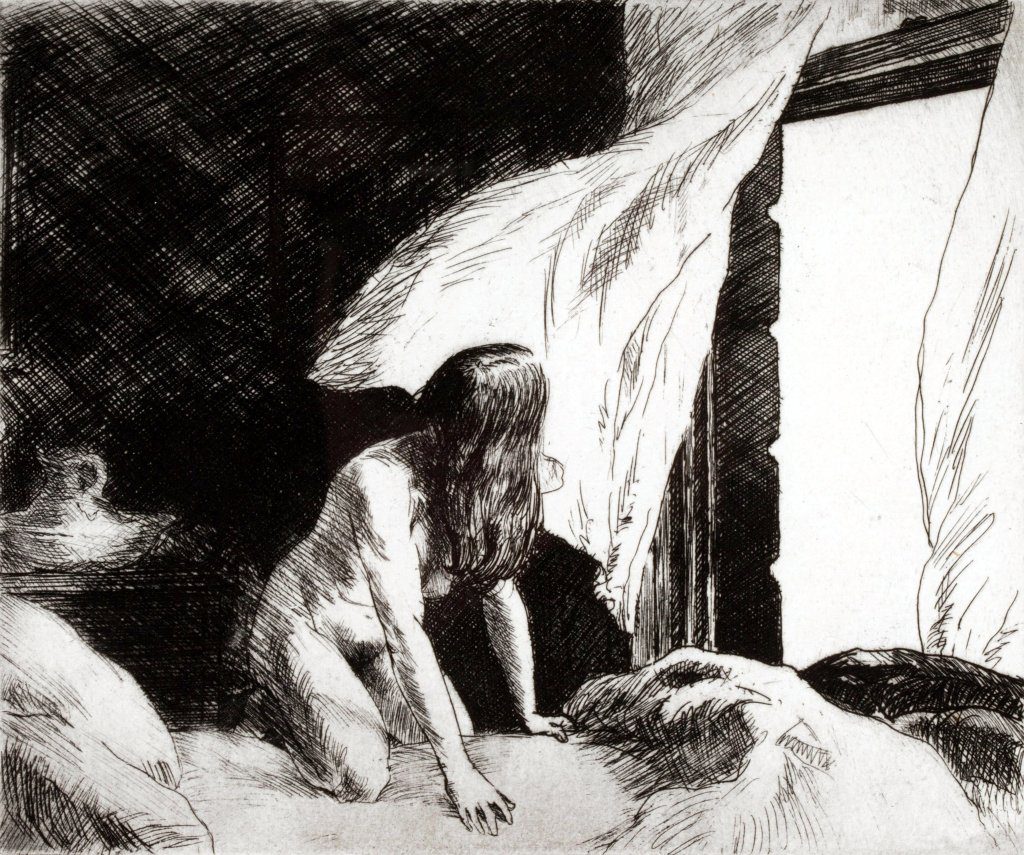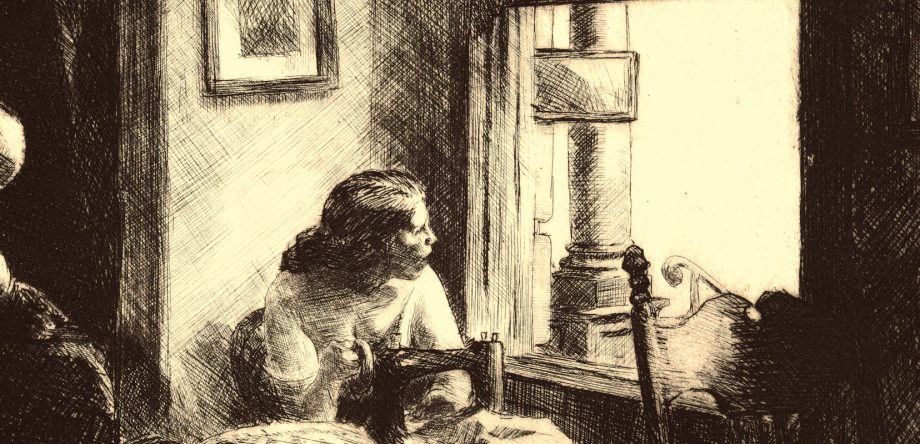I find solace in the strokes of a brush, the play of light and shadow, and the emotions that leap off a canvas. And when it comes to capturing the quietude of urban isolation, few have painted it as evocatively as Edward Hopper.
My Journey with Edward Hopper
Edward Hopper’s art transcends time, drawing me into a world of solitude hidden within bustling streets and dimly lit diners. My first encounter with his work was his painting “Gas”, a seemingly ordinary depiction of a gas station isolated in the landscape with a lone figure. This painting, like many of his works, resonated with me, its quiet solitude echoing the urban isolation I often felt.
Born in the heart of New York, Hopper’s early years in the city’s urban sprawl seeped into his very being, ultimately finding their expression on his canvases. As I delve deeper into his works, I can’t help but ponder the life of this masterful artist who wove his own experiences into his art, creating scenes that speak to the shared human experience of solitude amidst the clamor of city life.
Urban Isolation: A Profound Theme
Urban isolation is a profound theme that Edward Hopper masterfully explores in his works. It’s not merely the physical distance that separates individuals in a crowded city; it’s the emotional disconnect that often accompanies such a life.
One of the early paintings where Hopper beautifully captures this theme is “House by the Railroad” (1925). In this painting, an isolated house stands stark against a barren landscape, separated from the viewer by a set of railroad tracks. The house, with its closed doors and windows, seems cut off from the world, embodying the solitude and isolation that can be felt even amidst the bustle of urban life.
Hopper’s art is a profound exploration of this complex human experience. It’s as if he’s beckoning us to step into the frame, inviting us to share in the inner worlds of his subjects. His paintings, like “House by the Railroad”, serve as poignant reminders of the urban isolation that pervades modern life.
Iconic Works: A Glimpse into Solitude
Let’s delve deeper into two of Hopper’s iconic pieces that beautifully illustrate the theme of urban isolation: “Nighthawks” and “Automat”.
“Nighthawks”, completed in 1942, is perhaps Hopper’s most famous work. The painting was inspired by a restaurant on New York’s Greenwich Avenue where two streets meet. It portrays four people in a downtown diner late at night, as viewed through the diner’s large glass window. The light coming from the diner illuminates a darkened and deserted urban streetscape. The figures within the diner, the “nighthawks”, are amidst the clamor of city life, yet they remain islands of contemplation. Their world is ours, filled with silent conversations and moments of introspection.
“Automat”, painted in 1927, is another poignant depiction of urban isolation. The painting portrays a lone woman staring into a cup of coffee in an automat at night. The reflection of identical rows of light fixtures stretches out through the night-blackened window. Despite being in an all-hours Automat designed for the automatic delivery of drinks and snacks, the woman sits alone and appears lost in thought. This painting, like many of Hopper’s works, resonates with the viewer, its quiet solitude echoing the urban isolation that many of us have felt at some point in our lives.
These paintings, solitary figures amidst the clamor of city life, yet remaining islands of contemplation, are prime examples of urban isolation. Their worlds are ours, filled with silent conversations and moments of introspection. Through these works, Hopper invites us to share in the inner worlds of his subjects, providing a glimpse into the solitude that often accompanies urban life.
The Emotional Tapestry
Hopper’s art is an emotional tapestry, weaving feelings of solitude and reflection into every brushstroke. An early example of this can be seen in his painting “Evening Wind” (1921). This painting, featuring a solitary woman sitting on a bed, gazing out of an open window at a cityscape, is a poignant exploration of urban isolation. The woman, with her back turned to us, seems lost in thought, embodying the solitude that can be felt even amidst the bustle of urban life.

When I gaze at his work, I’m transported into a realm where quiet contemplation and deep emotions reign. His paintings hold a mirror to our inner worlds and evoke a sense of empathy that transcends time and place. The solitary woman in “Evening Wind”, her stark isolation amplified by the empty room around her, becomes a symbol of our own solitude, a reminder of the quiet moments of reflection that life offers us.
The Artistic Alchemy
Hopper’s unique style, characterized by his masterful use of light, color, and composition, deepens the sense of isolation within his paintings. Light becomes a storyteller, casting shadows that hint at hidden thoughts and feelings, drawing us closer to the scenes he creates.
An example of this artistic alchemy can be seen in his painting “Summer Evening”. In this piece, Hopper depicts a couple on a porch in the soft glow of the evening light. The play of light and shadow creates a sense of depth and adds a layer of complexity to the scene. The warm hues of the setting sun contrast with the cool shadows, highlighting the couple’s isolation even in their shared space.
The composition of the painting further enhances this feeling of isolation. The couple is placed off-center, surrounded by the expanse of the porch and the open space beyond. This use of space emphasizes their solitude, making them appear small and somewhat lost in the grand scheme of things.
A Timeless Legacy
Edward Hopper’s art is not confined to his own era. His unique style and the themes he explored have found resonance in modern times, influencing artists and filmmakers alike. His legacy lives on as a source of creativity and a reflection of the human condition in our contemporary society.
For instance, Alfred Hitchcock’s “Shadow of a Doubt” and Fritz Lang’s “Scarlet Street” are two films that clearly draw inspiration from Hopper’s work. In “Shadow of a Doubt”, the use of locations and the placement of characters within a given space are reminiscent of Hopper’s style. Similarly, “Scarlet Street” echoes Hopper’s themes of urban isolation and solitude.
In more recent times, the film “Hopper: An American Love Story” has also drawn, self-referentially, inspiration from Hopper’s work. This film strives to capture scenes imbued with similar light, and which is informed by the melancholy tone of the artist’s work.
These films, and many others, serve as a testament to Hopper’s timeless legacy. They capture the essence of his work – the exploration of urban isolation, the play of light and shadow, and the depiction of the human condition. Through their lens, Hopper’s art continues to live on, influencing and inspiring new generations of artists and audiences alike.
A Deeper Connection: Isolation Today
Many of us can relate to the profound isolation depicted in Hopper’s paintings, especially in a world where work and lifestyle often force us into long periods of seclusion. Whether within the heart of a bustling metropolis or in the quiet of a solitary room, Hopper’s art connects us to our shared experience of isolation.
If you, like me, have been moved by the emotional depth of Hopper’s art, it’s time to make it a part of your world. Explore our collection of prints inspired by his masterpieces and let urban isolation become a part of your own canvas. Welcome Hopper’s world into your space, where the boundaries of solitude and connection blur.




